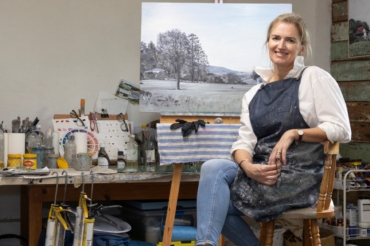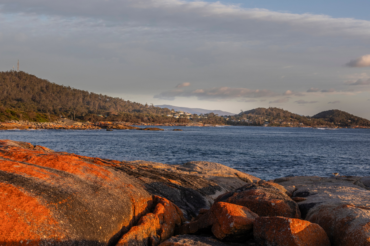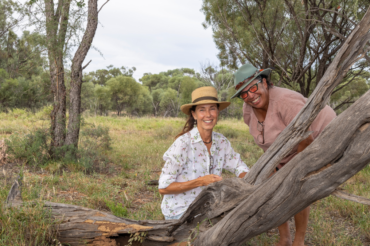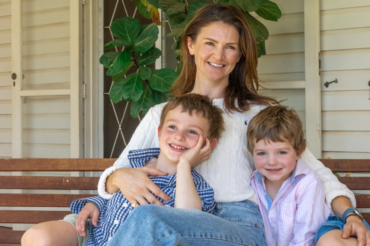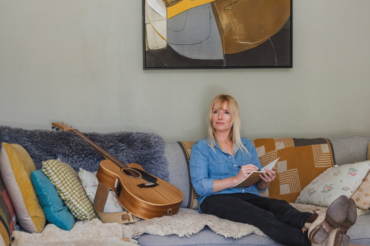
Stand close to almost any cliff on the Great Ocean Road, and you appreciate the perils of the shipwreck coast, serrated as a knife along the rim of the wild Southern Ocean. More than 700 hulks lie in the fathomless depths of this graveyard beneath the sea.
On a windswept bluff near Port Campbell, two headstones are tucked under heathland in a tiny cemetery marking the calamitous loss of the ill-fated Loch Ard in the pre-dawn hours of June 1, 1878. Far below, sea thunders over sunken reefs and foamy waves surge onto the beach curled like a fingernail at the bottom of a steep-sided canyon. This is the shape-shifting inlet of Loch Ard Gorge. It’s named after the clipper that hit a rocky island while sailing through the treacherous “eye of the needle”, a 90-kilometre gap on the south-west coast of Victoria, between Cape Otway and King Island. There were three survivors — an Irish beauty dragged to shore by a heroic cabin boy and a majestic porcelain peacock packed in a wooden crate that beached unscathed, but for a chip on its beak.
The Minton Peacock was headed for the Melbourne International Exhibition of 1880. Instead, it was hauled from harm’s way by a salvager who paid for the wreckage rights and kept it as a cherished family possession, all but forgotten by the wider world. Rediscovered, almost a century later, “the most significant shipwreck artefact in Australia” is now on display in a Warrnambool museum It’s a ripping yarn, an ordeal chartered in detail in a little book found slipped into an old writing desk at Port Cottage, where we’ve battened down the hatches for the night. There’s a kiss of malevolent weather over Port Campbell but plenty to captivate in a luxurious beach shack that’s awash with the flotsam and jetsam of the sea.

Outside, the waves boom against cliffs but, inside, a stash of hot-chocolate powders and single-malt whiskies confirms this as one of the most delightful ports in a storm on the Great Ocean Road. This ocean is a beast, no question, but it’s a beauty, too. Port Campbell is a bit like a bonus track on a record of greatest hits. It’s a quieter, slower pace of life, where the road loops from the old jetty and along a strip of charming shops, rising upwards into verdant pasturelands. We could take advice and bolt at sunrise for the nearby Twelve Apostles, but they can wait. Instead, we’re going against the groove, heading for the legion of small-scale producers and growers who are working to recapture that nostalgic notion of flavour on the 12 Apostles Food Artisans trail.
The gourmet trail entices foodies, and the merely greedy, through kilometres of inland crater country, past small towns and farm gates, tantalising the taste buds with home-churned ice cream, cheese, chocolate, berries, fudge, beer, spirits and more. Devotees of an epicurean beach picnic will be hard pressed to do better than the layered cheesecake (made to a family recipe from yoghurt-cheesy quark) at third-generation Schulz Organic Creamery and Cafe. “The trail is a story of community,” Hila Perry, the in-house pastry chef who joined Schulz Cafe after working at some of Melbourne’s top restaurants (Bibelot, Fat Duck, Dinner with Heston Blumenthal), affirms. It’s different here. “The hinterland has its own sweet rhythm and everyone supports each other.”

We cannot drive past the hand-crafted Apostle Whey cheesery or the infinite variety of Belgian couverture at Gorge Chocolates. Tasting is compulsory at the Timboon Ice Creamery and at the Timboon Railway Shed Distillery, where palatable lunchtime platters help to equalise exuberant visitors emboldened to tackle a wall of spirits. Most people think of the Great Ocean Road as a journey that runs from Melbourne, along the M1 motorway, covering 243km of coastline between Torquay and Allansford. With detours and the retur trip you will easily double that distance. This is unquestionably one of the world’s great natural wonders with a uniquely extraordinary sight in the towering limestone stacks — the Twelve Apostles — between Port Campbell and Princetown.
In reality, there were only ever nine sea stacks, but the number dropped to eight in 2005 with the constant battering of waves. Erosion of the limestone cliffs began 10 to 20 million years ago with the stormy ocean and blasting winds gradually wearing away the softer limestone to form caves in the cliffs. The caves became arches and, when these collapsed, rock stacks up to 45 metres high were cast adrift like sailors marooned at sea, isolated from shore. We are far from alone by the time we get to the Twelve Apostles car park. It’s just after lunch and the world is with us. It’s testimony to the enduring appeal of the Great Ocean Road that so many people choose to make it any way they can.

Multitudes arrive on day-tripper buses and the sight that delivers the dream feels a bit like a metropolitan hotspot in Delhi or Manilla, or Hong Kong or, yes, Melbourne. The lookouts are swarming with selfie-snappers on speed mode. Helicopters buzz overhead and the queue to the loo seems longer than the MCG on grand final day. Avoid the weekends, and the busy holiday periods, or come at either end of the day for a quieter wander along the weaving wattle-lined pathways. Stay longer in all this splendour and the rewards are likely to be even greater. Three to four days is just the beginning when you’re off the beaten track. It’s mid-week in the winter and we’re tackling the Great Ocean Road from a different angle, flying into Avalon Airport (south of Melbourne) to pick up a hire car, driving into the farmlands before returning to Melbourne.
On the Princes Highway, we avoid the bay and beach hordes, skirting around much-loved Lorne and Apollo Bay, unwinding ourselves through a heart-lifting landscape. There are beautiful walking stretches in the cool-temperate rainforests of the Great Otway National Park. Strap on the boots for Triplet and Hopetoun Falls or follow the sign to Otway Estate at Barongarook. Shouldn’t every trip start with a flight of five gins made by a small-batch producer using regional native botanicals? Naturally, a responsible driver is a necessity if safe passage is to be assured, driving along the dips and dives into green pastures and woodland groves. Tree ferns lean in and gum trees lean out.

There’s evidence of summertime migration in the tell-tale signs that urge drivers to remember that we “drive on the left in Australia” but the bitumen is blissfully free of pressures from the impatient. A dramatic stand of huge Californian redwoods, a remnant grove of immigrant giants planted in the 1930s, is now oddly out of place but wonderfully tranquil. From there, it’s a sweep down into Johanna Beach, a sandy bay with a view as far as the eye can see, eagles soaring over cliffs beside our cabin, The Roost. Dinner up at Lavers Hill is a pleasing affair where the welcoming warmth of The Perch is matched by its honey-timbered interiors. A crisp Chardonnay fits with home-made gnocchi and a coconut fish dish, which, pretty soon, instigates an idea that this nice neighbourhood eatery could, perhaps, move just a little closer to home.
We leave preoccupied by the chocolate avocado dessert, a uniquely and unforgettable subterfuge that takes significant engineering, but it’s outdone by the spectacle appreciated on the following day. The work of Christine Miller is a sight to behold. It’s hard to find words to describe Christine. She’s certainly a born and bred Nirranda farmer but she might be a small-town celebrity too. Her vibrantly joyous replica of the Loch Ard Peacock was front page news last year as the central float in Port Campbell’s Crayfest street parade. We’re pausing with Christine, on the road to Warrnambool, so that she can lead us down the garden path to a corrugated iron shed on the farm that’s been in family hands since 1888.

“Here it is,” she says, standing not nearly as tall as the brightly plumed bird adorned with plastic ivy and Styrofoam balls and mounted on wheels like a Dalek in Dr Who. “I wanted to make something that would stand out as representative of what we are on the shipwreck coast,” she says. “It took me 10 months to make it. I started in May 2022 and when I had it finished, I had a triple by-pass, so I told my family, ‘if I die, you still have to put him in the parade’.” It’s another magnificent survival story and, by now, we’re determined to find the real thing. For that, we must travel onwards, to the Flagstaff Hill Museum in the seaside city of Warrnambool where shipwrecks are more than mere remnants of disaster.
They’re poignant time capsules illustrating the enduring stories of migration, hope, survival, settlement, exchange and connection. In a way, the exquisitely glazed earthenware peacock in a glass cage is a fitting place to end the pilgrimage along this tattered shore. It’s the holy grail. An enduring legacy untouched by time, almost as perfect as the day it was made asan 1870s-conservatory decoration. The glorious bird is perched imperiously in the centre of the room. There’s nobody here. It’s like having the treasure all to oneself. There are, of course, always reasons to keep going. We pause to consider options with an afternoon of revitalisation and renewal in the geothermal rock-pools, sensory caves and cleansing waterfalls of the Deep Blue Hot Springs.

It’s not a long journey from Warrnambool to Lake Condah but time takes an entirely new meaning where the story of the Gunditjmara connection to country is the oldest in human history. The Budj Bim Cultural Landscape was created about 6600 years ago and is considered one of the world’s oldest freshwater aquaculture systems. It’s older than the pyramids, the Acropolis and Stonehenge and, recently, it’s become the first site in Australia to receive World-Heritage protection solely for its Aboriginal cultural importance. “It’s not just our truth, it’s us,” says tour guide coordinator Braydon Saunders. Visitors to the site can unlock country with an expert Indigenous guide explaining water flow and ecosystems manipulated to care for an intricate system of Kooyang (eel) traps and sink-hole holding ponds where eels have been fished over thousands of years.
The stone hut remnants are the only remaining evidence of permanent houses built by an Indigenous community in Australia, challenging the common perception that all Aboriginal people were nomadic. The circle of life is completed in the Tae Rak Aquaculture Centre, where a smart cafe floats coolly in a gauzy mist at the edge of a volcanic lake. Tasting platters are topped with delicious ribbons of brittle eel crackling and scrumptious arancini are flecked with smoked eel.

Dishes flavoured with river mint, lemon myrtle and kangaroo teach more about living off land and water through millennia. In the far distance, you can see the sacred domed site of Budj Bim, trace a straight line over peaks from the Grampians ranges to Cape Bridgewater on the coast to mark the journey of the creators. Our road trip has come to its end. Memories put Great Ocean Road stories of drama, survival, rescue and loss into context, but they’re really just dots on a map when eating smoked eel pâté with the oldest living culture on earth.
Photography by Anabel Dean, Bianca Jackson & Great Ocean Road Tourism

